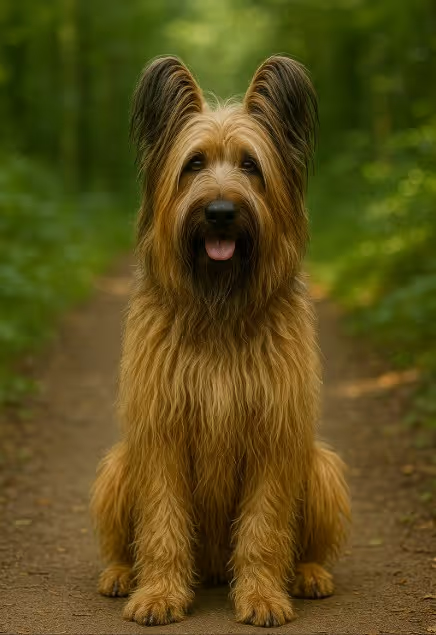The Briard is a large, shaggy-coated French herding dog—loyal, clever, and naturally protective. Famous for its flowing coat and double dewclaws on each rear leg, the Briard is affectionate with family yet reserved with strangers. If you’re asking “Are Briards good apartment dogs?”—possible for very active owners who meet exercise and grooming needs. “Are Briards hypoallergenic?”—no; shedding is moderate and regular brushing is essential.

An ancient French flock guardian and drover, the Briard (Berger de Brie) protected sheep from predators and herded stock across the countryside. Celebrated by Napoleon-era soldiers and French farmers, the breed became known for courage, steadiness, and keen hearing. Modern Briards retain strong herding and guarding instincts and excel in obedience, agility, herding trials, and therapy work when properly socialized and trained.
A robust, rectangular, strongly muscled herding dog cloaked in a long, protective coat.
High-maintenance coat that mats without a routine.
A serious worker—needs daily outlets for body and brain.
Bright, sensitive, and loyal—fair leadership and socialization are key.
Feed for lean muscle and joint health; avoid excess weight.
Generally robust, but size and breed-specific issues warrant screening.
Choose transparency on health, temperament, and grooming—or consider rescue.
Are Briards good apartment dogs?
Possible for very active owners—plan 60–90 minutes of daily exercise plus serious grooming.
Are Briards hypoallergenic?
No. They are not hypoallergenic; shedding is moderate and requires regular brushing.
Do Briards have double dewclaws?
Yes—double rear dewclaws are a hallmark of the breed; keep nails and surrounding hair trimmed.
How much grooming does a Briard need?
Brush 3×/week, bathe/dry every 4–6 weeks, and check mats in friction zones; expect 1–2 hours weekly.
How much exercise does a Briard need?
Plan for 60–90 minutes daily with training and brain games.
Do Briards bark a lot?
Moderate—alert/guardian voice. Teach a reliable “quiet” and reinforce calm greetings.
Are Briards good with kids and other pets?
Generally devoted family dogs with early socialization; supervise with small children and introduce other pets thoughtfully.
Briard vs Bearded Collie—what’s different?
Briards are larger, more guardian-leaning herders with double dewclaws and a drier, harsher coat; Beardies are lighter, bouncier, and typically more gregarious.
What health tests should breeders do?
Hips (± elbows), CAER eye exams, and CSNB/PRA DNA where relevant; discuss bloat prevention and family history.